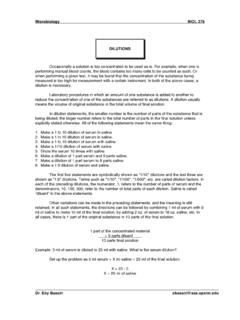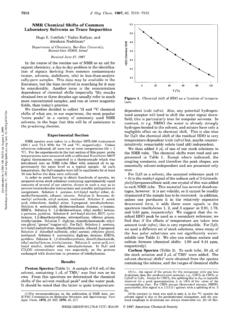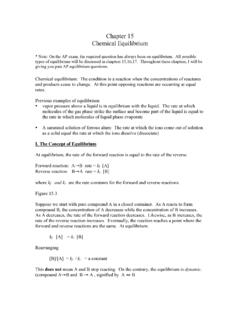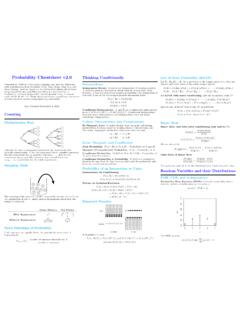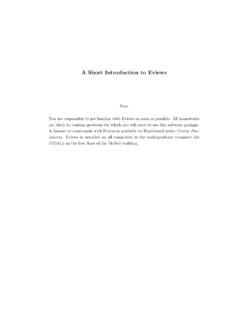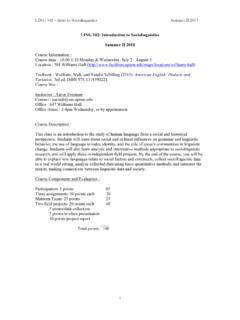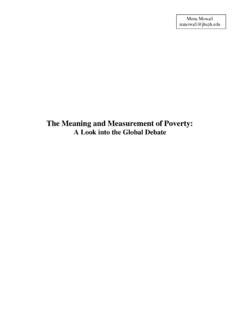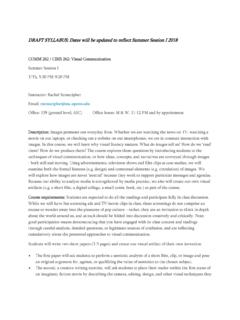Transcription of PREPARATION OF MEDIA I. OBJECTIVES II. INTRODUCTION
1 microbiology BIOL 275 Dr. Eby Bassiri 1 PREPARATION OF MEDIA I. OBJECTIVES To become familiar with the necessary nutritional and environmental factors for culturing microorganisms in the laboratory . To understand the decontamination or sterilization process using an autoclave. To learn the procedures used in preparing MEDIA needed for culturing microorganisms. II. INTRODUCTION Microorganisms depend on a number of factors such as nutrients, oxygen, moisture and temperature to grow and divide. In the laboratory , except for the above factors, the culture medium should be sterile and contamination of a culture with other organisms should be prevented. Let us briefly discuss a few of the more important factors for the growth of microorganisms. Nutrients A microbiological culture medium must contain available sources of hydrogen donors and acceptors, carbon, nitrogen, sulfur, phosphorus, inorganic salts and, in certain cases, vitamins or other growth-promoting substances.
2 These were originally supplied in the form of meat infusions that were, and still are in certain cases, widely used in culture MEDIA . Beef or yeast extracts can replace meat infusions. The addition of peptone provides a readily available source of nitrogen and carbon. Peptone is used in culture MEDIA to mainly supply nitrogen. Most organisms are capable of utilizing the amino acids and other simpler nitrogenous compounds present in peptone. Thus, in many cases, the complicated infusion MEDIA can be replaced by simpler MEDIA prepared by using the proper peptones in place of the meat infusions. Certain bacteria require the addition of other nutrients, such as serum, blood, etc. to the culture medium upon which they are to be propagated. Carbohydrates may also be desirable at times, and certain salts such as calcium, manganese, magnesium, sodium, and potassium seem to be required.
3 Dyes may be added to MEDIA as indicators of metabolic activity or for their selective inhibitory powers. Growth promoting substances of a vitamin-like nature are essential or assist greatly in the development of certain types of bacteria. Many of these substances are given for individual bacteria in Bergey's Manual of Determinative Bacteriology (Incidentally, this is a reference text that you should familiarize yourself with when working with microorganisms.) microbiology BIOL 275 Dr. Eby Bassiri 2 Oxygen Most bacteria are capable of growth under ordinary conditions of oxygen tension. Certain types, however, are capable of deriving their oxygen from various substrates. The aerobic organisms require the free admission of air, while the anaerobes grow only in the absence of atmospheric oxygen. Between these two groups are the microaerophiles that develop best under partial anaerobic conditions and the facultative anaerobes that develop under aerobic as well as anaerobic conditions.
4 It is easy to provide oxygen to aerobic and facultative anaerobic and even microaerophilic organisms; however, special gadgetry is required to exclude the atmospheric oxygen and provide an anaerobic condition. Such conditions are obtained by: Addition of a reducing substance to the medium Displacement of the air by carbon dioxide Absorption of the oxygen by chemicals Removal of oxygen by direct oxidation of readily oxidizable substances such as burning a candle, heating of copper, phosphorus or other readily oxidizable metals Incubation in the presence of germinating grain or pieces of potato Inoculation into the deeper layers of solid MEDIA , or under a layer of oil in liquid MEDIA or A combination of the above methods. Moisture Proper moisture conditions must prevail in the culture MEDIA for the growth of microorganisms. A moist medium and atmosphere are necessary for the continued luxuriant growth of cells.
5 For example, if a medium in a plate is inoculated with an organism and wet cotton is placed in the plate and sealed, the organism will show profuse growth. The same organism might fail to show growth if the medium plate is not sealed and is too dry. pH The pH of the culture medium, expressed as hydrogen ion concentration [H+], is extremely important for growth. The majority of microorganisms prefer culture MEDIA that are approximately neutral, while others may require a medium that is distinctly acidic. Temperature Every organism shows a rather general curve of growth as affected by temperature. Such a curve shows 1) a minimum temperature below which growth stops, 2) an optimum temperature at which growth is luxuriant and 3) a maximum temperature above which the organism dies. Microorganisms are divided into three main groups (mesophilic, psychrophilic and thermophilic) as far as optimum temperature requirements are concerned.
6 The usual range of temperature suitable for the growth of mesophilic microorganisms lies between 15-43 C. Psychrophilic microorganisms have, however, been known to grow and multiply at 0 C. Thermophilic organisms may grow at temperatures even greater than 80 C. In general, the microbiology BIOL 275 Dr. Eby Bassiri 3 pathogenic organisms have a temperature requirement of around 37 C (body temperature) while saprophytes have a much broader latitude. Medium Support The consistency of a liquid medium may be modified by the addition of agar, gelatin or albumin in order to change it into a solid or semisolid state. In the early 19th century, infusions of plant and animal tissues, solutions of organic compounds, and gelatin (as a solidifying agent) were employed as MEDIA for the growth of microorganisms. However, gelatin had two main disadvantages; being liquid at 37 C (incubation temperature), and being liquefied or digested by many bacteria.
7 Bacteriology as a science began with the development of methods for the cultivation of bacteria, and the INTRODUCTION of agar by Hesse in the 1890's was a step of greatest importance. Agar is actually credited to Fanny Hesse, wife, technician and assistant of the German physician Walter Hesse. Agar-agar, long used as an agent in preparing fruit jellies was suggested by Mrs. Hesse as a replacement and became the standard solidifying agent in microbiology . The properties of agar which make it ideal in bacteriology are 1) solid agar melts (dissolves) at 100 C, 2) remains solid at all incubation temperatures, 3) is transparent, 4) is not heat-labile and therefore easily sterilized, and 5) is unaffected by almost all bacteria. Liquid agar solidifies at 42-44 C which is useful because sterile, heat-labile components such as antibiotics, blood, serum, carbohydrates and even bacterial cultures may be added before allowing the medium to solidify.
8 Solid MEDIA generally contain agar at a concentration of Semi-solid MEDIA contain agar and are useful in culturing anaerobic and microaerophilic organisms because such MEDIA form an oxygen gradient in test tubes, allowing all degrees of oxygen tension to exist in the culture vessels. Sterile Conditions & Autoclaving The MEDIA upon which microorganisms are grown must be sterile or free from all other forms of microbes. The usual method for sterilization of culture MEDIA is by means of the autoclave in which steam under pressure is the sterilizing agent. Autoclave sterilization for 15 minutes at 15 pounds of pressure and at 121 C is recommended for quantities of liquid MEDIA up to one liter (1 L). These settings are called the standard autoclaving conditions. If larger volumes are to be sterilized in one container, and if the medium is not hot when placed in the autoclave, a longer period should be employed.
9 The medium is prepared according to formula, distributed in tubes or flasks which are then plugged with nonabsorbent cotton or loosely capped before being placed in the autoclave. Plugs should fit neither too loosely nor too tightly. Screw cap tops or metal covers may also be used to close the tubes or flasks. Tubes should be placed in racks or packed loosely in baskets. Flasks should never be more than two-thirds full. After the sterilization period has been completed, the source of steam is cut off and the autoclave is allowed to return to atmospheric pressure. Pressure should not drop too rapidly or the MEDIA will boil over, blowing the plugs from the tubes or flasks. Pressure should, however, microbiology BIOL 275 Dr. Eby Bassiri 4 drop rapidly enough to prevent excessive exposure of the MEDIA to heat after the sterilization period. The usual procedure for using the autoclave is as follows: 1.
10 Open door, and place items to be sterilized into the autoclave chamber. Be sure that anything containing fluid is plugged with styrofoam, cheesecloth, cotton, a Morton cap or else screw caps are slightly loose. 2. Close door. Push down door lock lever until door studs are completely in place. 3. Turn hatch wheel clockwise until it is secured tightly. 4. The temperature of the autoclave is set at 121 C. If not, set the temperature by sliding the upper (yellow) arrow to the desired temperature. Do not touch the bottom indicator arrow. If you adjust to any temperature other than 121 C, return it to 121 C at the end of the run. 5. Set timer by turning the large knob just below the hands to the desired setting. DO NOT TOUCH the hands, they break very easily! 6. Set cycle selection knob to desired setting. Remember, all liquids MUST be done at SLOW EXHAUST. Dry materials can be done at Fast Exhaust or Fast Exhaust and Dry.
